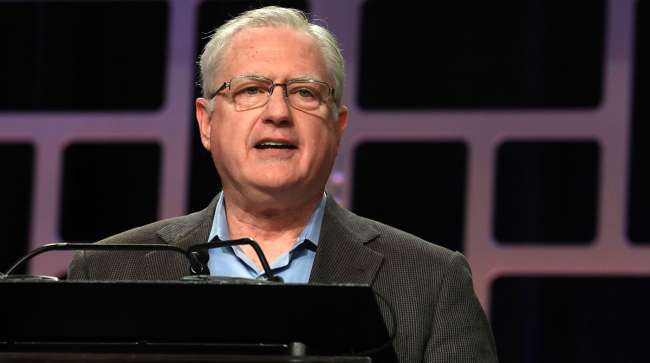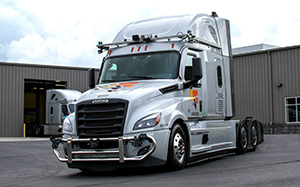Managing Editor, Features and Multimedia
DTNA’s O’Leary Urges Fleets to Prepare Now for Electric, Automated Future

[Stay on top of transportation news: Get TTNews in your inbox.]
ORLANDO, Fla. — Daimler Truck North America CEO John O’Leary urged fleets and maintenance shops to begin planning for the emergence of electric-powered and increasingly automated trucks.
“The time to prepare is now,” said O’Leary, who outlined his vision for the future of commercial trucks on March 8 during the kickoff of the Technology & Maintenance Council 2022 Annual Meeting & Transportation Technology Exhibition.
O’Leary said advances in connectivity, electrification and autonomy will transform the commercial vehicle market.
The most important meal of the day! We started Tuesday with our amazing Kickoff Breakfast Speaker, John O’Leary, president and chief executive officer, Daimler Trucks North America. Thank you to our sponsor @DaimlerTruckNA #tmcannual22 pic.twitter.com/Vrdvv0Jueb — Technology & Maintenance Council (TMC) of ATA (@TMC4Trucks) March 8, 2022
“I know these technologies need to be practical. None of us wants to see science projects on the road,” he said. “But after watching development accelerate at an exponential pace in each of these areas in the last few years, and the pull from customers asking for it, I can confidently say that we will deliver on this trifecta of goals.”
The industry must make investments today to support the smooth introduction of these technologies in the future, O’Leary said.
“I implore each of you, each of your shops, to start preparing for these shifts now,” he said. “This isn’t tomorrow. This isn’t next week. This won’t even be next year. But the shift is coming, and we must embrace it and start to plan for it.”
In the coming years, fleet maintenance locations will need to install electric-vehicle charging equipment, he said. Highly automated trucks that will run longer hours and more miles also will require more frequent service and sensor calibrations.
“As has been the case through our industry’s long history, maintenance operations will continue to be the lifeblood of our nation’s logistics network,” O’Leary said.
He also acknowledged the production challenges that vehicle manufacturers are facing due to supply chain constraints, including shortages of semiconductors and other components.
“I know you need more parts. I know you need more trucks. Believe me when I say that keeps me up at night,” he said. “We all want to break through the current supply chain snarls and ensure the fastest turnaround imaginable for you and your customers.”
Looking ahead, O’Leary sees the trucking industry moving toward battery-electric trucks, but that transition will not happen overnight.
“Let me be abundantly clear that while we very much believe in the technology, we are looking not at a light-switch moment, but at a very long ramp-up period where diesel continues to serve the bulk of the industry’s needs,” he said. “But the day is coming when zero-emission propulsion systems will become the dominant technology.”
DTNA’s ambition in the United States is to offer exclusively carbon dioxide (CO2)-neutral products by 2039.
“This is our goal, so we are making pragmatic investments now to build momentum for the long term,” O’Leary said.

Daimler and Torc test trucks with SAE Level 4 intent technology on public roads in Virginia in September 2019. (Daimler Trucks and Buses)
Last year, DTNA opened order boards for its battery-electric Class 8 Freightliner eCascadia and medium-duty eM2 models. The eCascadia is set to enter series production late this year, followed by the eM2 in early 2023.
DTNA also is working to support the development of charging infrastructure for its electric trucks. The company is offering fleet consulting services and has partnered with companies such as BlackRock and NextEra Energy to lay the groundwork for a public charging network.
Looking further on the horizon, DTNA is investing in hydrogen fuel cell technology, which could serve as a range extender for electric trucks and make zero-emission trucking more feasible in longhaul applications.
O’Leary said DTNA intends to add a hydrogen-powered truck to its portfolio late in this decade.
Meanwhile, the longstanding push to enhance the fuel economy of diesel trucks continues to make progress. DTNA has improved the fuel efficiency of its flagship Freightliner Cascadia model by more than 35% since its introduction in 2007 through aerodynamics and engine improvements, O’Leary said.
On the safety front, O’Leary highlighted the development driver-assist features such as automatic emergency braking and lane-keeping assist that are preventing crashes and saving lives.
Those types of increasingly advanced safety features are helping to pave the way for trucks equipped with SAE Level 4 automated driving technology, which would enable the driver to fully relinquish control of the truck under certain conditions.
That technology could help address rising freight demand and worsening driver shortages by allowing trucks to run longer, farther and more efficiently than ever before, O’Leary said.
“To get there, we see a long glide path remaining, one whose timeline for us will be dictated exclusively by safety,” he said.
DTNA is partnering with Level 4 truck developers Waymo and Torc Robotics. The manufacturer envisions offering customers a choice of autonomous driving systems, not unlike providing multiple powertrain options.
Want more news? Listen to today's daily briefing above or go here for more info
All of these technologies are coming at a time when the dynamics of global commerce are changing rapidly.
Citing data from the Bureau of Transportation Statistics, O’Leary said the value of freight shipments by truck is expected to nearly double between 2018 and 2045. At the same time, final-mile delivery is expected to continue growing and consumers are demanding faster shipping.
DTNA expects those trends to continue.
“We’re looking at nothing short of fundamental change in the way that people order and receive everything, from furniture to prescriptions and groceries,” O’Leary said.


&uuid=(email))
